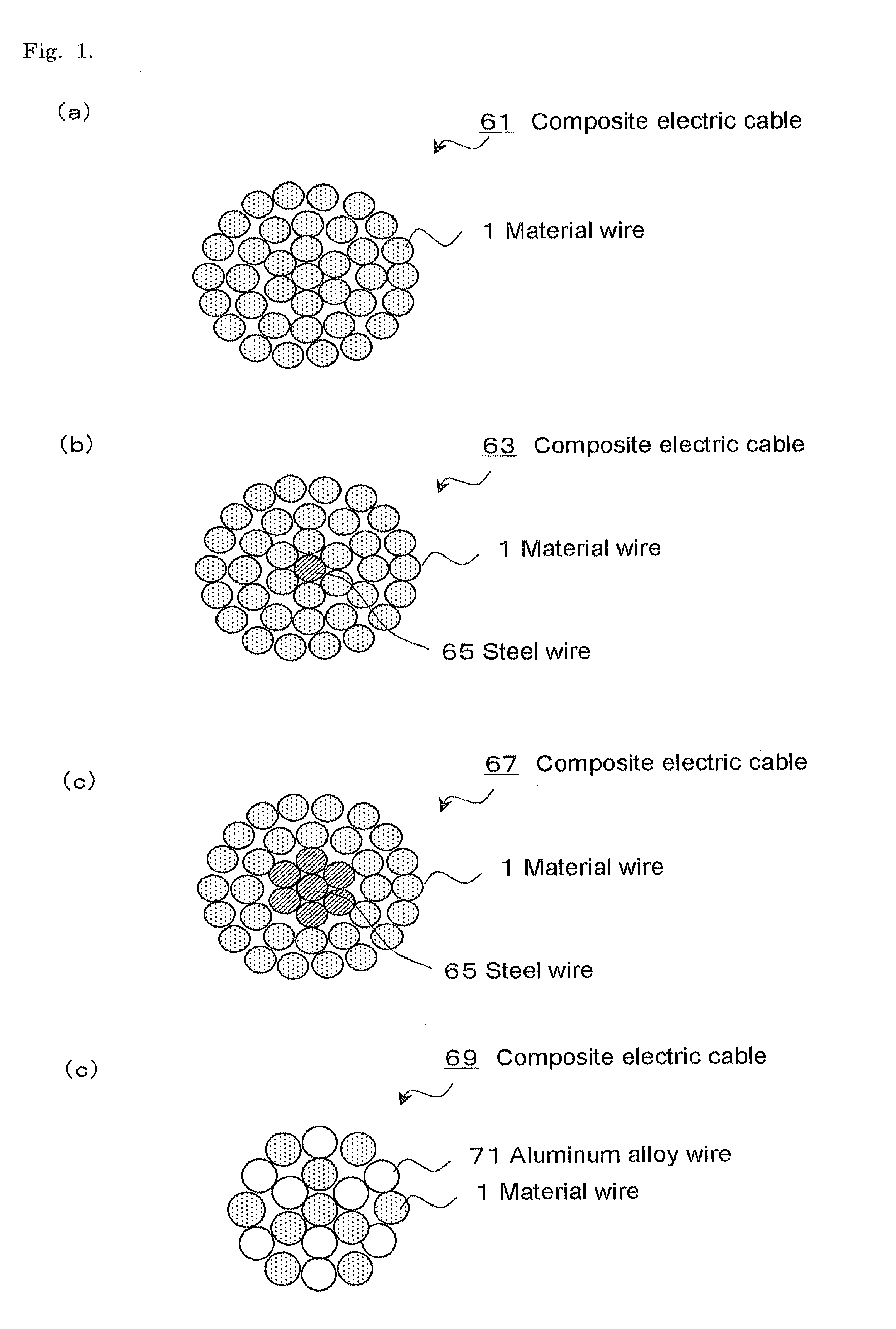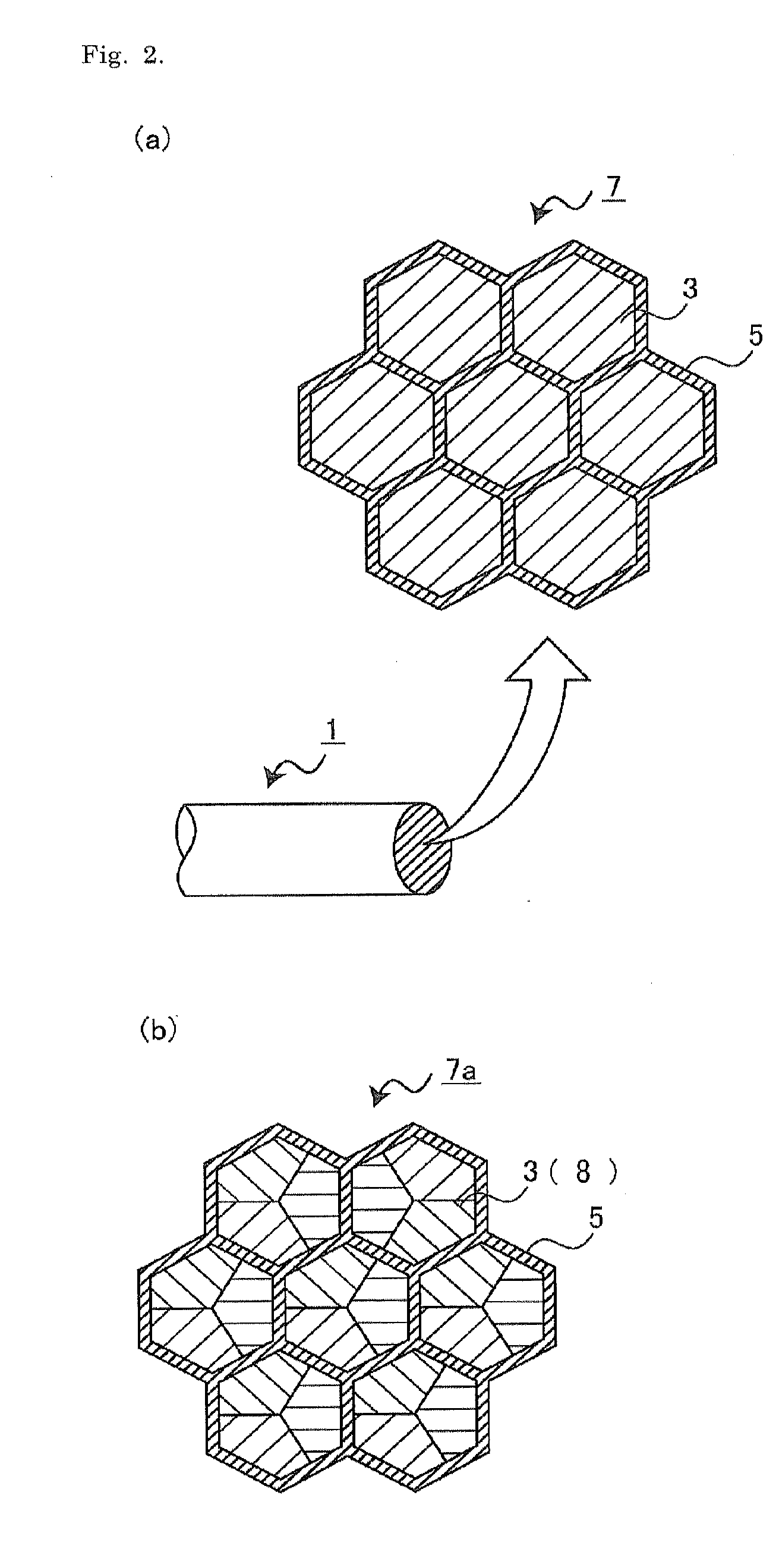Composite electric cable and process for producing same
a technology of composite electric cables and electric cables, which is applied in the direction of power cables, insulated conductors, cables, etc., can solve the problems of carbon nanotubes that cannot meet the needs of plastic working, the electrical connection and thermal contact between carbon nanotubes and metals cannot be sufficiently ensured, and the material is not suitable for plastic working, etc., to achieve excellent electrical conductivity and high mechanical strength
- Summary
- Abstract
- Description
- Claims
- Application Information
AI Technical Summary
Benefits of technology
Problems solved by technology
Method used
Image
Examples
second embodiment
[0131]The second embodiment will next be described.
[0132]FIG. 6 is a schematic view of a material wire 41 of the second embodiment. In the second embodiment, the same members as employed in the first embodiment are denoted by the same reference numerals, and overlapped descriptions are omitted. Notably, as shown in FIG. 6 with an arrow, the upper part of FIG. 6 is an enlarged schematic view of a part of the cross section of the core portion 43 shown in the lower part of FIG. 6.
[0133]The material wire 41 includes the core portion 43 and a clad portion 45, the core portion 43 containing carbon nanotubes and having the cellulation structure 7, and the clad portion 45 containing no carbon nanotube or having a carbon nanotube concentration lower than that of the core portion 43 and having no cellulation structure 7.
[0134]In the material wire 41, the core portion 43, having a cellulation structure, is difficult to undergo wire drawing, whereas the clad portion 45 having no cellulation str...
third embodiment
[0137]The third embodiment will next be described. FIG. 7 is a schematic view of a material wire 47 of the third embodiment. Notably, as shown in FIG. 7 with an arrow, the upper part of FIG. 7 is an enlarged schematic view of a part of the cross section of the clad portion 51 shown in the lower part of FIG. 7.
[0138]The material wire 47 includes the clad portion 51 and a core portion 49, the clad portion 51 containing carbon nanotubes and having the cellulation structure 7, and the core portion 49 containing no carbon nanotube or having a carbon nanotube concentration lower than that of the clad portion 51 and having no cellulation structure 7.
[0139]An alternative example of the third embodiment is a material wire 53 shown in FIG. 8. As shown in FIG. 8, the clad portion 51 may be further coated with a coating part 55. The coating part 55 is formed of an aluminum material having no cellulation structure. According to this mode, the material wire 53 has a region having no cellulation s...
example 1
Production of a Billet Having a Cellulation Structure
Step (a):
[0149]Natural rubber (100 g, 100 parts by mass) was fed to a gap between 6-inch open rollers (roller temperature: 10 to 20° C.) so that the rubber covered the rollers. To the natural rubber covering the rollers, aluminum particles (500 parts by mass) as metal particles were fed, and the rubber and the aluminum particles were kneaded. The roller gap was adjusted to 1.5 mm. Subsequently, carbon nanotubes (25 parts by mass, 5 wt. % with respect to aluminum material) were fed to the open rollers. The mixture was removed from the rollers, to thereby yield a mixture of the elastomer, aluminum material powder, and carbon nanotubes.
[0150]In Example 1, natural rubber was used as the elastomer, pure aluminum (JIS A1050, mean particle size: 50 μm) was used as the aluminum material powder, and multi-layer carbon nanotubes (mean diameter: 13 nm, product of ILJIN) were used as the carbon nanotubes.
Step (b):
[0151]The mixture obtained in...
PUM
| Property | Measurement | Unit |
|---|---|---|
| Temperature | aaaaa | aaaaa |
| Fraction | aaaaa | aaaaa |
| Pressure | aaaaa | aaaaa |
Abstract
Description
Claims
Application Information
 Login to View More
Login to View More - Generate Ideas
- Intellectual Property
- Life Sciences
- Materials
- Tech Scout
- Unparalleled Data Quality
- Higher Quality Content
- 60% Fewer Hallucinations
Browse by: Latest US Patents, China's latest patents, Technical Efficacy Thesaurus, Application Domain, Technology Topic, Popular Technical Reports.
© 2025 PatSnap. All rights reserved.Legal|Privacy policy|Modern Slavery Act Transparency Statement|Sitemap|About US| Contact US: help@patsnap.com



